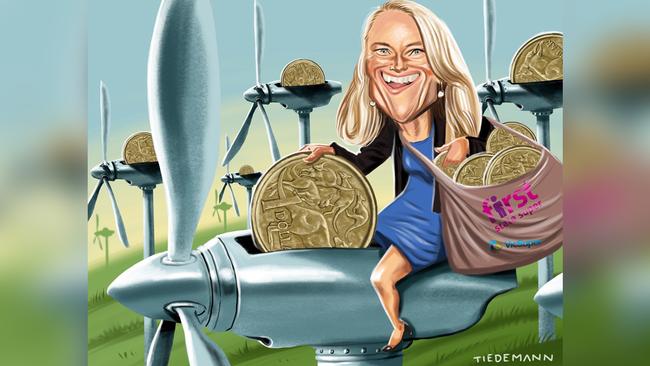
A pivotal player in the game is 33 per cent shareholder The Children’s Investment Fund Management. The hedge fund is another believer, having been a patient, long-term holder of the old Babcock and Brown vehicle. Babcock was a stockmarket darling in the early part of the century before one too many deals and too much debt saw it collapse in 2009.
But some key personnel are still involved, including Infigen chief Ross Rolfe who took founding boss Miles George’s job after they worked together at B&B, the latter as head of B&B power in the good old days, and restructuring guru Sylvia Wiggins who serves as finance chief.
Infigen is one of the remaining B&B relics, along with Alinta Energy, and Brookfield’s Australian base is built around the infrastructure assets.
The collective talents have, however, left Infigen the carrier with too much expensive debt at around $454m, expensive equity and, in short, in not too good financial shape.
The flurry took place just when think-tank Beyond Zero Emissions (BZE) was launching its million-jobs report on Monday, aimed at framing discussions on how to boost jobs through renewable energy investment. The Infigen takeover battle took some strange turns.
The BZE discussion was about how, in the wake of COVID-19, a substantial push into renewables could create jobs and finally realise the nation’s potential for wind and solar energy.
Spanish wind giant Iberdrola took just 23 minutes to respond to a higher bid on Monday morning from the 186-year-old Philippine conglomerate UAC, which suggests the Spaniards were expecting the move from its rival.
Presumably UAC had approached majority Infigen shareholder TCI Fund Management about its move to match the Spanish bid at 86c a share, free of conditions.
That tipped off the Spaniards, which is why the response came so quickly, even though it was 1am on a Monday in Spain.
Why so fast? The Infigen board may have gone with the Spaniards in any case.
UAC will take some time to respond, although that is a relative term in this battle.
The Infigen board now has a conditional higher offer of 89c from the Spaniards and must decide whether that is enough to maintain its recommendation.
The Foreign Investment Review Board is expected to approve the bid any day now, but it’s not a lay-down misere that the higher bid gets the recommendation.
Credit Suisse is advising UAC, Lazard is advising Infigen and Nomura is advising Iberdrola.
Atlassian’s Mike Cannon-Brookes, speaking on Monday at a panel supporting the BZE one million jobs report, noted: “We can build a renewable energy superpower with a very low cost of energy.
“One of the things I really like about the million jobs plan is it’s not about inventing new technologies.
“It’s about deploying the technologies we already have today at scale to generate jobs and economic prosperity for Australia. That’s exactly the direction we need to be heading in.”
There are six companies in the S&P top 50 list that account for 59.6 per cent of carbon emissions, starting with AGL at 18.8 per cent, followed by South32 at 11.1 per cent and Rio at 9 per cent.
First State Super’s Deanne Stewart said: “We have proven how we can adapt through this pandemic and we now have a unique opportunity to reset our economy and consider more deeply what the jobs and industries of the future might be.
‘‘We know that sustainable businesses, communities and economies will be successful in the long term and are better able to withstand unexpected economic shocks.
“Now, we have an opportunity to be innovative and bold, to challenge the norm and seek new initiatives to drive the jobs growth of the future and rebuild our economy.
“One way First State Super is doing this is through investments in jobs-creation initiatives supporting small to medium-sized businesses to access the growth capital they need to take the next step in their development.
“Last year we also made our first direct investment in renewable energy in Australia and are setting clear targets to increase our commitment to renewables and new technology.
“We are also determined to be part of the solution to the housing affordability issue, having already invested more than $200m in key worker affordable housing initiatives over the past 12 months, with plans to double this investment in the next year,” she added.
Corporate director Kevin McCann noted that all state governments had committed to net zero emissions by 2050 but Canberra was yet to commit.
He urged an end to bipartisan gridlock.
Costa Rican diplomat Christiana Figueres told the conference that this “may be Australia’s best last chance”.
The climate change specialist noted she had been waiting for Australia to make the best of its resources.
The policy report is intended as a framework for discussion, with suggestions including mandating local content on wind turbines and tiger renewables, electrification of public transport, new transmission lines to renewable centres and retrofitting public housing based around renewable energy.
The overwhelming view of the panel was that now is the time to forget bipartisan politics and the time for action is overdue.
Subsidies for renewables is yesterday’s news — wind and solar are now an established part of energy supply but what is needed is rational co-ordination of the assets.
Household solar is good at producing maximum output at midday, driving prices to zero, so more wind power is necessary and in different locations to diversify inputs like a good equities portfolio.
What should be clear to the naysayers is that smart money is chasing Australian wind assets.
Maybe federal government policy will catch up one day.
Super giant
Wednesday will see the creation of Australia’s second-biggest superannuation fund when First State and Vic Super merge after 18 months of discussion to create a $125bn giant.
When and if Sun Super and Q Super merge that will create a $195bn fund, becoming the largest.
Australian Super with $185bn under management is the product of 18 mergers over time.
The official merger between Sta and ARF had 1.2 million members and $21bn under management. Today it has 2.2 million members.
The federal government has turned the funds into a bank of last resort through the early access program in which 340,000 AustralianSuper members have taken out $2.5bn or an average of $7500 each.
By contrast, the $25bn Vic Super has had 10,500 members take out $85m while First State has seen 35,000 members take out $300m.
The latter two tend to be public service-based memberships.






The $868.6m battle for wind energy producer Infigen between a Spanish and Filipino company tells you the market thinks there is value upside in renewables.